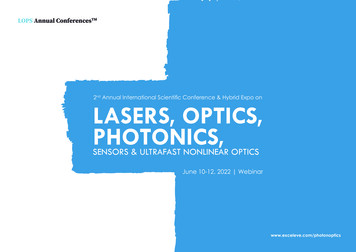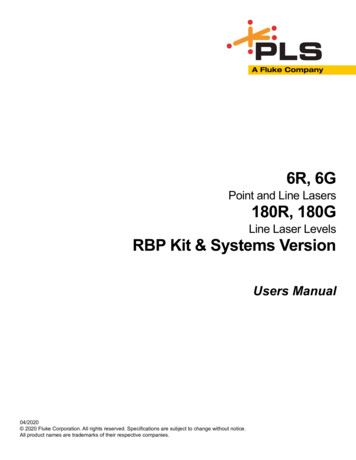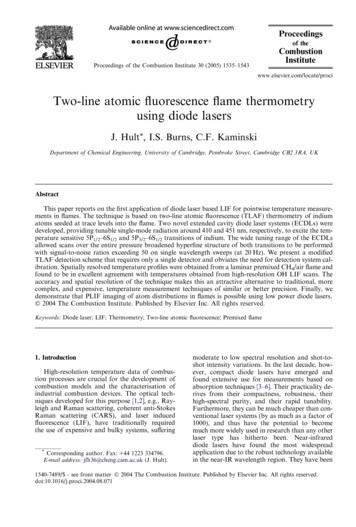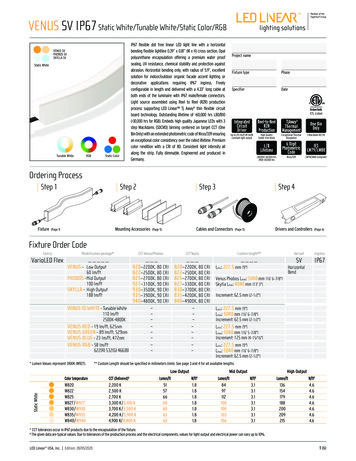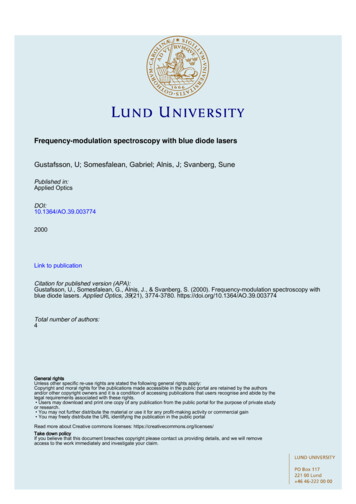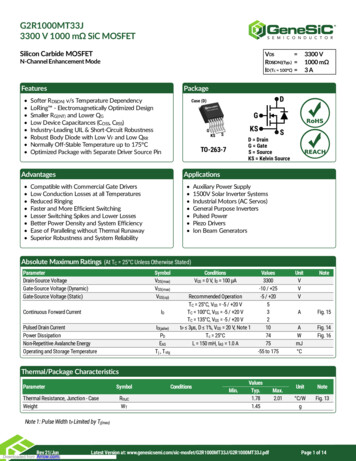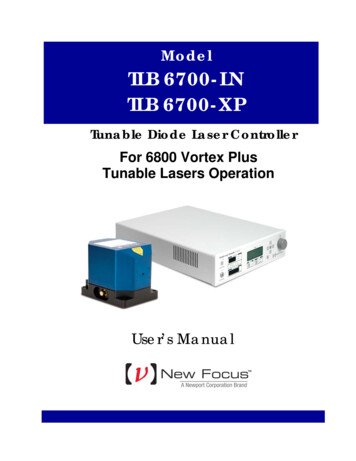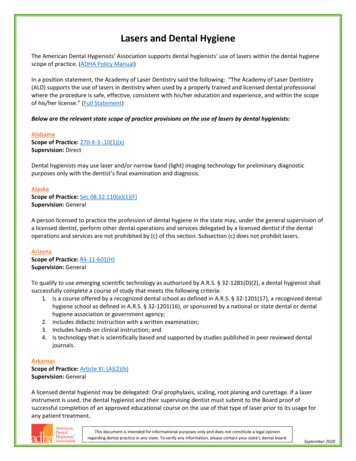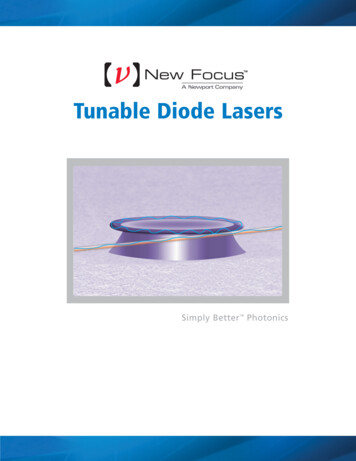
Transcription
Tunable Diode LasersSimply Better PhotonicsP h o n e : 1 - 8 7 7 - 8 3 5 - 9 6 2 0 w w w. n e w p o r t . c o m / N e w F o c u s
Simply Better PhotonicsNew Focus: Simply Better PhotonicsTMFounded in 1990 with the missionof providing Simply Better Photonics Tools, New Focus hasbuilt a portfolio of highperformanceproductsthatincludes tunable lasers, optoelectronics,high-resolutionactuators, stable optomechanics, vacuum and ultracleansolutions, and OEM engineered solutions. Our products areused in demanding applications around the world insemiconductor equipment, bio-medical research, industry,test and measurement and advanced research.As part of Newport we continue our focus on making greattools for scientists and researchers.We are taking all theengineering we have learnt in the industrial world and haveremade all our legacy tunable lasers and high speedelectronics products. You will see the results of that in thenew products we have launched recently.We believe tools that you use in the lab should be just that,simple and reliable tools, not an experiment in a box.Need a wavelength or tuning range that you do not see?Smoother linearity or a tighter linewidth? Let us know, theseare the real-life challenges we get excited about trying tosolve.We still know that good engineering requires an in-depthknowledge of our customers, their visions and problems, andhow technology can make their applications really work. Andwe still want to have fun helping researchers do the bestscience they can.Talking face to face is great so let us know if you are going tobe in the Silicon Valley. We would love to show you aroundour new facilities, or just drop by our booth at a trade showor conference.We look forward to hearing from you.On the CoverThe toroid microresonator is an intriguing photonic devicethat can be used to confine and store light for up to hundredsof nanoseconds.As with many other opticalmicroresonators, the toroid can be fabricated on Si (“onchip”) from glasses, polymers, and III-V binarysemiconductors. The image shows an artistic rendition of atoroid microresonator being resonantly excited by light at ablue wavelength propagating through the optical fiberwaveguide. The toroid is sensitive to its environment andhas been proven to work in biological and particle sensing; ithas been used as a microlaser because of the large lightintensity that can be built up in its ring; it has also been usedto generate a frequency comb spanning hundreds ofnanometers. Indeed, this versatile on-chip device continuesto be the focus of much research, has found myriadapplications, and therefore demands Simply BetterTMPhotonics.P h o n e : 1 - 8 7 7 - 8 3 5 - 9 6 2 0 w w w. n e w p o r t . c o m / N e w F o c u s
Tunable Diode LasersNew Focus Application GuideNew Focus lasers and optical amplifiers are used by top scientists and engineersaround the world, both in lab and industry, in a variety of cutting edge applications.ApplicationsSeriesTLB-6600 Venturi Swept-Wavelength Tunable LasersAvailableWavelengthsTuning Range835-1630 nm Fiber-Bragg sensing Spectroscopy Telecom test and measurement MetrologySwept WavelengthWide Mode Hop Free TuningTLM-8700OEM Tunable Laser Modules835-1630 nm Spectroscopy Microcavity Resonators Nitrogen Vacancy Centers (NV-Centers) SensingTLB-6700 Velocity Widely Tunable Lasers635-1630 nmWide and FineMode Hop Free Tuning Atom cooling Magneto-optical Traps Bose-Einstein Condensates Atomic ClocksTLB-7100 Vantage Tunable Diode Laser392-867 nmWide Tuning andMode Hop Free fine tuning Interferometry Metrology Atomic Clocks Atom cooling, trapping and BECTLB-6800 Vortex PlusTunable Lasers455-1630 nmMode Hop FreePrecision Fine Tuning Laser Cooling Magneto-optical Traps Bose-Einstein Condensates Optical Amplification of CW sourcesTA-7600 VAMP Tapered Semiconductor Amplifiers755-920 nmFixed Wavelength Raman spectroscopy Interferometry Terahertz generation Data encryption LIDARSWL-7500Single Wavelength Diode Lasers633-1610 nmP h o n e : 1 - 8 7 7 - 8 3 5 - 9 6 2 0 w w w. n e w p o r t . c o m / N e w F o c u s1
2Simply Better PhotonicsTunable External Cavity Diode LasersTunable External Cavity Diode Lasers (ECDLs) are employedin many applications, including coherent opticaltelecommunications, atomic and molecular laserspectroscopy, laser cooling, atomic clocks, environmentalsensing, and optical microcavities. In addition to tunability,these applications often require narrow linewidth singlemode operation. Semiconductor diode lasers typicallyoperate with several longitudinal modes lasingsimultaneously, leading to low coherence and largelinewidths. One method of extracting highly coherent lightfrom a semiconductor-based laser requires that you antireflection (AR) coat the diode so it acts only as a gainHR-coatedend faceelement. The diode can then be placed in an external cavitythat contains wavelength-selective optics so that only asingle mode lases at any given time.To enable tuning across the diode gain band twoconfigurations, Littrow and Littman-Metcalf, are typicallyemployed. These utilize a grating to provide optical feedbackinto the diode chip, as illustrated in Figure 2. In the Littrowdesign, mode is selected by rotating the diffraction grating.In the Littman-Metcalf design, the grating remains fixed andmode selection occurs by rotation of an additional mirror inthe cavity.AR-coatedend faceOutputOutputCouplerLensFigure 1. Laser diode placed into an external cavity.The anti-reflection coating prevets the diode fron self lasingFigure 2: Tunable external-cavity diode lasers in Littrow and Littman-Metcalf configurationLittman-Metcalf vs. Littrow ConfigurationsThere are advantages and disadvantages to both theLittman-Metcalf and Littrow cavity designs. In general, theLittrow design results in higher output laser power; however,advances in chip manufacturing technology and opticalcoatings have led to higher power Littman-Metcalf ECDLs.The optical feedback in a Littrow is much stronger and highquality AR coatings on the diode facet, which can bechallenging, are not critical as it is for the Littman-Metcalfdesign. Therefore, many diodes, specifically the blue andother exotic wavelengths can be incorporated into a Littrowcavity and not in a Littman-Metcalf cavity. The LittmanMetcalf achieves mode-hop-free tuning ranges in the 10s to100s of nanometers and the Littrow typically has less than atenth of a nanometer mode-hop-free tuning.P h o n e : 1 - 8 7 7 - 8 3 5 - 9 6 2 0 w w w. n e w p o r t . c o m / N e w F o c u s
Tunable Diode LasersMode-hop-free Wide Tuning New Focus LasersTrue single-mode tuning requires that the optical feedback be dominated by the external optics and not by reflections fromthe diode facet. We use AR-coated diodes to reduce residual diode reflectivities to below 0.001 which guarantees singlemode operation.We place the diode in an external laser cavity that is based on a modifiedLittman-Metcalf configuration. In this cavity, a grazing-incidencediffraction grating and a tuning element provide all the necessarydispersion for single-mode operation. The amplitudes of non-lasingmodes are suppressed to 40 dB below the lasing mode.WavelengthTuningTuningElementHR CoatingAR CoatingLaser-Diode ChipCollimating LensDiffraction GratingLaser OutputA modified Littman-Metcalf configuration.The wavelength in a modified Littman-Metcalf laser is changed by tiltingthe retroreflector, which changes the diffracted wavelength fed back intothe cavity. To prevent mode hopping, the cavity length must be kept at aconstant number of wavelengths as the laser tunes. This requires that thepivot point around which the element tilts be positioned with sub-micronaccuracy. Using a patented pivot-point location technique, we producelasers with truly continuous, mode-hop-free tuning across tens ofnanometers.Free Space Power, 780785Wavelength, nmWide, Mode-hop-free tuning of the Model TLB-6728 VelocityWhich laser configuration is right for my application?When your application calls for wide mode-hop-free tuning, high stability, and hands-off ease of use, select the LittmanMetcalf. When the wavelength you need is not available in a Littman-Metcalf or you need higher power without wide modehop-free wide tuning, select the Littrow.P h o n e : 1 - 8 7 7 - 8 3 5 - 9 6 2 0 w w w. n e w p o r t . c o m / N e w F o c u s3
4Simply Better PhotonicsLinewidth and Frequency StabilityOnce single-mode operation is established by the optics inthe external cavity, the linewidth of the laser can be affectedby acoustic coupling and cavity temperature variations, eachof which can change the cavity length. It is also affected byelectrical noise coupling, which causes changes in the indexof refraction of the diode and in the piezo length (alsoaffecting the cavity length).Since various noisecontributions occur on different timescales (thermal acoustic electrical), the length of time over which alinewidth measurement is taken is important.Representative linewidths are measured over milliseconds.Linewidth as a Function of Integration Time-50.0 dB-55.0-60.0-65.0Heterodyne beat note of two VelocityTLB-6712 lasers, 50 ms integrationtime. Deconvoluted FWHM 200 kHz.-70.0-75.0-80.0-85.0-90.07.28383E 97.30000E 97.32000E 97.34000E 97.35383E 9Frequency, HzWhat is meant by instantaneous linewidth?Besides the time dependent jitter component in the linewidth, the timeless intrinsic linewidth is determinedby the cavity design. This can be measured by heterodyning on a very short time scale (less than 1 ms) witha real-time spectrum analyzer or with any spectrum analyzer by matching the resolution bandwidth to thelaser linewidth. The signal strength on the spectrum analyzer will only drop if the resolution bandwidth issmaller than the heterodyned signal.Wavelength DriftLB1005 Servo ControllerLonger time wavelength drifts (over seconds) of narrow-linewidth tunable lasersoccur due to floor vibrations, small temperature drifts, and even acoustic noise frompeople talking in the vicinity of the laser. The “free-running” linewidth, or short-termstability of the laser, is often not adequate for many applications without activestabilization of the laser frequency. The wavelength can be stabilized by usingfeedback control of the tuning element. In order to do this, an optical reference suchas a gas cell or high finesse optical cavity is used to provide feedback to thepiezoelectric transducer (piezo) that controls the grating or tuning arm to shift thelaser wavelength so that it remains fixed to the stable resonance line shape of thereference, regardless of external perturbations.P h o n e : 1 - 8 7 7 - 8 3 5 - 9 6 2 0 w w w. n e w p o r t . c o m / N e w F o c u s
Tunable Diode LasersThe Philosophy of New Focus LasersNew Focus lasers are designed to be complete and easy-to-use systems.Complete SystemsNew Focus laser systems are plug-and-play, fully-functioningsystems which include active current drive and closed looptemperature control.TLB-7100 Vantage Laser and TLB-6800-LN Controller.Laser Head RecognitionSafety FeaturesFor systems with modular laser heads and controllers,critical diode settings, mximum current and optimumtemperature are stored in the laser head. These criticalparameters are determined and set at the factory during thebuild of each individual laser unit. The correspondingcontroller calls this information from the laser head onstartup ensuring top performance.The critical settings stored in the laser head prevent fataldamage to the tunable laser system, particularly to the laserdiode or tapered amplifier chip. The preset maximumcurrent value prevents the user from delivering too muchcurrent. Each tapered amplifier has a safety shutoff featurethat is enabled when the seed drops below a safe power.DesignOver the decades, New Focus has accumulated vast ECDL engineering and production know-how. This knowledge shows inour design. Mechanical design, including Star-FlexTM actuation and magnetic damping reduce vibrational noise. Heavy housing and thermal insulation for temperature and acoustic isolation. Low noise control electronics for narrower linewidths.What is Magnetic Damping?The New Focus Velocity, Vortex Plus, and Vantage Lasers incorporate patent pending magnetic damping to improve laserstability. External vibrations coupled into the laser cavity can excite the natural mechanical frequencies of the laser tuningarm. A magnet is placed behind the tuning arm to dampen the amplitude of these unwanted vibrations that lead to laserfrequency instability and linewidth broadening.P h o n e : 1 - 8 7 7 - 8 3 5 - 9 6 2 0 w w w. n e w p o r t . c o m / N e w F o c u s5
6Simply Better PhotonicsTLB-6700 Velocity Widely Tunable Lasers Guaranteed mode-hop-free tuning across entiretuning range Coarse and fine wavelength control Internal permanent fiber coupling Armored output fiber LabVIEW control availableSelect the Velocity for applications requiring wide(many nanometers) mode-hop-free tunability.Optomechanical Modal Spectroscopy (OMMS) (bottomimage) of the natural vibrations of on-chip micron-scaledspheres is described by Tal Carmon (U of Michigan) andKerry J. Vahala (Caltech) (Phys. Rev. Lett. 2007). CW opticalpower evanescently coupled into these silicon spheresinduces excitation of eigen-frequencies via the centrifugalradiation pressure of the optical whispering-gallery-mode.These oscillations are then monitored by measurement ofthe modulated transmitted power. Perturbations in thesestructures result in degeneracy splitting of the vibrationalmodes, analogous to Stark splitting of atomic and molecularexcited states.Photo courtesy of Ashley Maker, Andrea Armani lab, University of Southern California.The New Focus Velocity Widely Tunable Laser delivers modehop-free wavelength tuning for OMMS and other microcavityresearch, such as bio-detection and harmonic generation.Microtoroid Resonators (top image) are photonic devicescapable of confining and storing light for up to severalhundred nanoseconds. Laser light propagating through atapered optical fiber waveguide is evanescently coupled intoa microtoroid initiating a second, longitudinally propagatingwave through the rim of the microtoroid. The image,obtained in the lab of Prof. Andrea Armani (USC), shows lightat 410 nm being evanescently coupled into a silicamicrotoroid. These longitudinal Whispering Gallery Modes(WGMs) can be used as probes of the microtoroid’senvironment.Photo courtosy of Tal Carmon (U of Michigan) in collaboration withKerry Vahala, CaltechP h o n e : 1 - 8 7 7 - 8 3 5 - 9 6 2 0 w w w. n e w p o r t . c o m / N e w F o c u s
7Tunable Diode LasersAt New Focus we take pride in all of our products. We are especially proud of theVelocity Widely Tunable Laser Series. The Velocity offers complete single-modetuning across its entire specified wavelength, over tens of nanometers and apiezoelectric transducer allows for fine tuning over 50-100 GHz.150 dB-25-45-65765nm780nm795nmFrequency, HzThe Velocity has a side mode suppression ratio of 60dB (model dependent)-50.0 dB Huge mode-hop-free tuning range-55.0 Motorized and Piezo control for wide scanningand fine tuning-60.0-65.0 Higher power-70.0 Improved stability, 200 kHz linewidth-75.0-80.0 Integrated permanent fiber coupling-85.0-90.07.28383E 97.30000E 97.32000E 97.34000E 97.35383E 9Frequency, HzHeterodyne beat note of two Velocity TLB-6712 lasers, 50ms integrationtime. Deconvoluted at FWHM 200 kHz070.06300Free Space Power, mW-206700-40RIN, 0.00100-1405010.070.00-120760765770775Frequency, HzRIN test data for the Velocity 6700 and previous model Velocity 6300Wavelength, nmMode-hop-free tuning range of the Velocity TLB-6712P h o n e : 1 - 8 7 7 - 8 3 5 - 9 6 2 0 w w w. n e w p o r t . c o m / N e w F o c u s780785
8Simply Better PhotonicsMore Robust The enlarged drop-tested and shock proof housing ensuresa robust system. Thicker insulation increases thermal and mechanicalisolation. Integrated optical isolator and fiber coupling eliminatesfiber misalignment. Armored output fiberHigh Power With a redesigned system, we are now able to incorporatethicker diodes, giving you more power to deliver to yourexperiments.Low Noise More powerful temperature control reduces wavelengthdrift and power fluctuations. Magnetic damping stabilizes the tuning arm and reducesvibrational noise. A new controller delivers more current and less noise,narrowing the laser linewidth.Mechanical schematic of the TLB-6700 laser platformTLB-6700-LN Tunable Laser ControllerThe 6700 Tunable Laser Controller has been engineered withdirect feedback from our customers. We have increased thecurrent to allow higher power from our lasers and reducedthe noise even further for sharper linewidths and betterresults. The 6700 Controller monitors the Velocity laserscurrent, temperature, and wavelength. Each head hasoptimized factory settings. The 6700 Controller will read thelaser's optimum settings and automatically limit the currentand scan ranges to protect the laser diode cavity. Operationis simple: either from the front panel or via the USB GUI, theuser can just dial up and set the desired wavelength andpower. Minimum and maximum wavelengths points can beentered, and the Velocity can be set to scan back and forthbetween them. Higher current – 200 mA now standard Lower noise 250 nA RMA with 200 mA current Wavelength monitoring of Velocity laser head Complete tuning control - set a wavelength range formultiple scans USB interface allows for remote user control via GUITLB-6700-LN controllerP h o n e : 1 - 8 7 7 - 8 3 5 - 9 6 2 0 w w w. n e w p o r t . c o m / N e w F o c u s
Tunable Diode LasersVelocityTM 712TLB-6716TLB-6718TLB-6721Min Mode-Hop Free Tuning Range2635-638 nm729-739 nm765-781 nm830-853 nm945-975 nm1030-1070 nmMin Mode-Hop Free Tuning Range (Fine-Frequency) 80 GHz (110 pm) 80 GHz (140 pm) 80 GHz (150 pm) 60 GHz (150 pm) 50 GHz (160 pm) 50 GHz (200 pm)Free Space Power38 mW @ 638 nm20 mW @ 737 nm50 mW @ 780 nm50 mW @ 850 nm30 mW @ 960 nm60 mW @ 1064 nmMax Tuning Speed5 nm/s8 nm/s8 nm/s10 nm/s10 nm/s10 nm/sTypical Beam Size width (50 ms Integration Time) 200 kHz (50 ms Integration time)Wide Tuning Resolution0.01 nmFine-Frequency Modulation Bandwidth 2 kHzMax Current Modulation Bandwidth4 1 MHz 1 MHzMax Current Modulation Bandwidth5 100 MHz 100 MHzSpecifications1Min Mode-Hop Free Tuning 67301045-1085 nm1270-1330 nm1390-1470 nm1470-1545 nm1520-1570 nm1550-1630 nmMin Mode-Hop Free Tuning Range (Fine-Frequency) 50 GHz (200 pm) 50 GHz (290 pm) 30 GHz (200 pm) 30 GHz (210 pm) 30 GHz (240 pm) 30 GHz (260 pm)Free Space Power340 mW @ 1080 nm30 mW @ 1300 nm45 mW @ 1450 nm15 mW @ 1470 nm30 mW @ 1550 nm30 mW @ 1600 nmMax Tuning Speed10 nm/s15 nm/s15 nm/s15 nm/s20 nm/s20 nm/sTypical Beam Size width (50 ms Integration Time) 200 kHz (50 ms Integration time) kHzWide Tuning Resolution0.01 nmFine-Frequency Modulation Bandwidth 2 kHzMax Current Modulation Bandwidth4 1 MHzMax Current Modulation Bandwidth5 100 MHzSpecifications are subject to change.2Contact New Focus for all available wavelength ranges.3Fiber coupled and optical isolator options available.4Current modulation through controller.5Current modulation directly to diode through laser head SMA port.1OptionsFiber Coupled (-P)*Comments 30% efficiency for models 6704, 6716 35% efficiency for model 6721, 6722 50% efficency for models 6711, 6712, 6718, 6724, 6725, 6726, 6728, and 6730Permanently coupled fiber, steel jacketedFC/APC, PM, Panda, 1m lengthIsolator (-OI)35 dB typical isolation.70 dB available as a custom (will include removable fiber patchcord, FC/APC, PM, panda, 1m length).Isolation may vary by wavelength. 75% power transmission.P h o n e : 1 - 8 7 7 - 8 3 5 - 9 6 2 0 w w w. n e w p o r t . c o m / N e w F o c u s9
Simply Better PhotonicsTLB-6600 Venturi Swept-Wavelength Tunable Lasers Ultrafast 2000 nm/s tuning enables true real-timemeasurements Ultrawide 110 nm mode-hop-free tuning 70 dB ASE low-noise version for high-dynamic-rangetest and measurement Multiple integrated options available0Select the Venturi for applications requiring mode-hop-free widewavelength sweeping, such as for telecom and fiber sensing.Pwer, dBm10The TLB-6600 lasers deliver it all. They combine the best intunability—ultrafast, ultrawide, and mode hop-free—with lownoise, high accuracy and repeatability. Because the lasers arebased on our award-winning design, they are extremelydependable with OEM-proven 24/7 reliability (over 100-millioncycles tested without failure). Ideal for fiber sensing,spectroscopy, laser seeding, metrology and fiber-optics testing,these lasers are available with a variety of options so you canbuild the system you need.8642015101530155015701590Wavelength, nm16101630Power stability for the Model TLB-6600-H-CL across tuning range10000201,000 nm/s100 nm/s10 nm/s.TLB-6600-H-CL andTLB-6600-L-CL0Power, dBmTuning Speed, velength, th, nmTuning linearity for the model TLB-6600-H-CLCarrier and ASE for Venturi modelsTLM-8700 OEM Swept-Wavelength Lasers Ultrawide 110 nm mode-hop-free tuning Tuning speeds greater than 2000 nm/s OEM-proven reliability ( 100-million cycles tested)Just like all of our benchtop tunable lasers, these modulescarry our reputation as the leading supplier of test-andmeasurement tunable lasers. If you have specific needs,please do not hesitate to contact us. We want to work withyou to develop a design that is right for you. The TLM-8700OEM laser module is just one example of our OEMcomponent portfolio. New Focus designs, develops, andmanufactures custom optical solutions for a broad selectionof companies in all branches of the photonics industry.P h o n e : 1 - 8 7 7 - 8 3 5 - 9 6 2 0 w w w. n e w p o r t . c o m / N e w F o c u s
Tunable Diode LasersVenturi -L-CLTLB-6600-H-OTLB-6600-L-OMode-Hop Free Tuning Range (nm)1520-1630 nm1510-1620 nm1265-1345 nm1265-1345 nm835-845 nmTuning Speed2-2,000 nm/s2-2,000 nm/s2-2,000 nm/s2-2,000 nm/s5-1,000 nm/s 30 pm 30 pm 30 pm 30 pm 30 pm 1 mW 3 mWWavelength ResetabilityTLB-6600-840 15 pmAbsolute Wavelength AccuracyAbsolute Wavelength Accuracy(with PWR option) 1 pmOutput Power (fiber-coupled) 6 mW 1 mWOutput Power Flatness (swept) 4 mW 50 dBcASE 40 dB 70 dB 40 dB 70 dB 40 dBIntegrated Dynamic Range 15 dB 55 dB 15 dB 55 dBN/ASMSMFiber Optic ConnectorFC/APCFiber TypeIntegrated Options Available2SM or PMSM or PMPWR, VOA, PC, RMPWR, VOA, PC, RMSM1. Specifications are subject to change.2. PWR - Precision Wavelength Reference, VOA - Variable Optical Attenuator, PC Polarization Controller, RM - Rack Mount. Contact New Focus for futher details.OptionsIntegrated Precision Wavelength Reference ModuleAccuracy 1 pmRepeatability 1 pmInsertion Loss1.0 dB (max)Polarization Dependent Loss (PDL)0.1 dB (max)Valid Sweep Rates10–200 nm/sWavelength Range ExcludedNoneFiber Type (input/output)SM/SMModelTLB-6600-PWRWavelength Reference option available for CL version only.Integrated Polarization Controller, 6-StateSOP Generated6-SOP: -45 , 0 , 45 , 90 , RHC, LHCSOP Repeatability 1 on Poincaré sphereSOP Switching Speed250 msRotation Angle Wavelength Dependence0.068 /nmInsertion Loss1 dB (typical)Insertion Loss Variation with SOP0.1 dB (max)Insertion Loss Variation with Wavelength0.2 dB (max)Fiber Type (input/output)PM/SMModelTLB-6600-PCPolarization Controller option available for the CL version. When ordering the integrated Polarization Controller(-PC) option, you must also order a Polarization Maintaining fiber output (-PM) to couple the light to the -PC.The final output will be from a single-mode (-SM) fiber.Integrated Variable Optical AttenuatorAttenuation Range 20 dBAccuracy0.1 dB (typical across range)Excess Loss 0.7 dB (max)Polarization Dependent Loss (PDL)0.2 dB (max)Fiber Type (input/output)SM/SMModelTLB-6600-VOAGain and P-I corner are independently adjustable.P h o n e : 1 - 8 7 7 - 8 3 5 - 9 6 2 0 w w w. n e w p o r t . c o m / N e w F o c u s11
12Simply Better PhotonicsTLB-6800 Vortex Plus Tunable Lasers Exceptional ease of use Wide mode hop free tuning Direct diode access for high RF speed modulation Widest mode-hop-free piezo tuning of any commerciallyavailable tunable ECDL including blue wavelengths Star-Flex Actuation of the tuning arm for maximumstability Function generator built into the TLB-6800-LN controllerSelect the Vortex Plus when extremelystable and wider piezo tuning is requiredsuch as for precision spectroscopy, laserphysics, and interferometry.The strontium optical lattice clock at JILA works byreferencing an ultra-stable clock laser to laser-cooled andtrapped strontium atoms. Strontium is one of nature’shighest-Q frequency references, with a quality factor of 1018.This clock takes advantage of the lower quantum projectionnoise of a many-body quantum system to achieve newrecords in clock precision, stability, and total systematicuncertainty. To prepare the atoms for precisionspectroscopy, they are first laser-cooled using light from 461nm blue diode lasers. Then, after a second red laser coolingstage, the atoms are loaded into an optical lattice, wherethey are trapped in standing waves of light. The clock laseris then used to perform coherent spectroscopy. The bluelight is used again to measure the number of atoms in theground and excited states via fluorescence. This allows us tomeasure the laser frequency against the atomic resonance.Strontium Optical Lattice - Courtosy ofProf. Jun Ye, UC Boulder, JILA, NISTP h o n e : 1 - 8 7 7 - 8 3 5 - 9 6 2 0 w w w. n e w p o r t . c o m / N e w F o c u s
Tunable Diode Lasers13Precision Tunable Laser Evolution of Excellence1996Introduced in 1996 the Vortex 6000Series Tunable Lasers offered narrowlinewidth and low-noise performancebuilt to our customer’s wavelengthspecifications. Based on a provenmonolithic design, there were noadjustable components that couldbecome misaligned over time. Thelaser cavity and drive electronics weredesigned to provide maximumfrequency-modulation capabilities,allowing for modulation above thefrequencyofmechanical-noisesources.2004Vortex Stablewave 2008Vortex IIThe New Focus engineering team wasonce again asked to provide the nextlevel of laser performance that wouldhelp the atomic spectroscopycommunity and others by providinglow frequency jitter and low driftmode-hop-free tunable laser. TheVortex II 6900 Series, the thirdgeneration fine tuning ECDL designreleased in 2008, was even moreresistant to acoustical and mechanicalperturbations than its predecessor.The technical challenge came down tostiff rotational motion withouttranslation. It was under this mandatethat Star-Flex motion actuation andthe patented technique of magneticdamping were born.In 2002, New Focus partnered withNASA’s Jet Propulsion Laboratory(Pasadena, CA) to develop the nextgeneration atomic clocks formicrogravity measurements andGPS space deployment, as part of anexperiment to test many of thepredictions of Albert Einstein’sTheory of Relativity. New Focusproudly released the Stablewave7000 Series in 2004. To deliver trulyreliable performance, these lasersused an exceptionally rugged,patented laser cavity.2012Vortex PlusThe Vortex Plus is the latest addition to the New Focus lineof Finely Tunable Littman-Metcalf Lasers. Conserving thesame robust cavity and StarFlex actuator, New Focus hasadapted the Vortex II to accept longer diode chips, resultingin significantly higher output power. The Vortex Plusoperates with our low noise TLB-6800-LN laser controller,reducing the laser linewidth from 300 kHz to 200 kHz. Also,an SMA port for direct diode current modulation has beenreintroduced to the Vortex Plus, enabling up to 100 MHz highspeed modulation.P h o n e : 1 - 8 7 7 - 8 3 5 - 9 6 2 0 w w w. n e w p o r t . c o m / N e w F o c u s
Simply Better Photonics-20-40Response, dB14Previous Design-60Vortex equency, HzStar-Flex actuator design of the TLB-6800 Vortex Plus laser.Frequency responce of Vortex II in compareson with original Vortex (100 dB whitenoise test). The Vortex II has improved stability due to the Star-Flex design andmagnetic damping.The Star-Flex design was engineered to be robust enough towithstand a space shuttle launch environment and operatefor years in space. The design had to pass strict tests to meetthe requirments for space readiness. You can see just howmuch of a difference the new design made to the RIN test ofthe Vortex laser in the above plot.TLB-6800-LN Low Noise Controller Interchangeable laser heads High-speed current modulation Easy frequency modulation Complete control of laser parameters Complete computer control and LanVIEWTM programs Detector and general-purpose input Built-in function generatorThe Model TLB-6800-LN laser controller is designed to operate with either the TLB-6800 Vortex Plus Tunable Lasers orTLB-7100 Vantage Tunable Lasers. The controller allows you to easily fine tune and adjust the output power or bias currentwith the press of a button or, via the USB/RS-232, interface with the click of a mouse. There is no need for an external functiongenerator to drive the piezo of your tunable laser with the built in function generator. The TLB-6800-LN controller has easyto access front panel controls, digital interface, and real buttons to make your lab life easier.P h o n e : 1 - 8 7 7 - 8 3 5 - 9 6 2 0 w w w. n e w p o r t . c o m / N e w F o c u s
Tun
New Focus: Simply Better TM Photonics Founded in 1990 with the mission of providing Simply Better Photonics Tools, New Focus has built a portfolio of high-performance products that includes tunable lasers, opto-electronics, high-resolution actuators, stable optomechanics, vacuum and ultraclean solutions, and OEM engineered solutions. Our .
